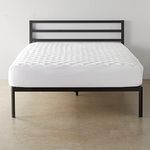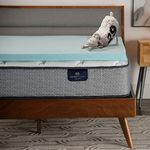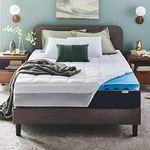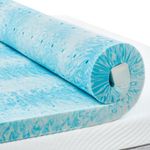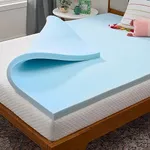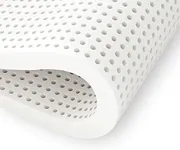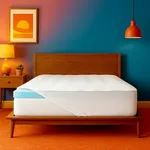Buying Guide for the Best Hypoallergenic Mattress Toppers
Choosing the right hypoallergenic mattress topper can significantly improve your sleep quality, especially if you suffer from allergies. A hypoallergenic mattress topper is designed to reduce allergens like dust mites, mold, and pet dander, providing a cleaner and healthier sleeping environment. When selecting a mattress topper, it's important to consider several key specifications to ensure you get the best fit for your needs.MaterialThe material of a hypoallergenic mattress topper is crucial because it determines how well it can resist allergens. Common materials include memory foam, latex, and down alternative. Memory foam is known for its comfort and support, but it should be certified to be free from harmful chemicals. Latex is naturally hypoallergenic and resistant to dust mites and mold, making it a great choice for allergy sufferers. Down alternative is a synthetic option that mimics the feel of down but without the allergens. Choose a material that aligns with your comfort preferences and allergy needs.
ThicknessThickness affects both comfort and support. Mattress toppers typically range from 1 to 4 inches thick. A thinner topper (1-2 inches) can add a slight layer of comfort and is suitable if you don't need much extra support. A medium thickness (2-3 inches) provides a balance of comfort and support, ideal for most sleepers. A thicker topper (3-4 inches) offers maximum cushioning and is best for those who need significant pressure relief or have a firm mattress. Consider your current mattress condition and your personal comfort needs when choosing the thickness.
DensityDensity is a measure of how much material is packed into the topper and affects its durability and support. Higher density toppers (4-5 pounds per cubic foot) are more supportive and durable, making them suitable for heavier individuals or those needing more support. Medium density (3-4 pounds per cubic foot) offers a good balance of comfort and support for most people. Lower density toppers (2-3 pounds per cubic foot) are softer and less supportive, ideal for lighter individuals or those who prefer a plush feel. Match the density to your body weight and support needs.
Cover MaterialThe cover material of a hypoallergenic mattress topper can enhance its allergen-resistant properties. Look for covers made from natural, breathable fabrics like cotton or bamboo, which are less likely to trap allergens. Some covers are treated with antimicrobial agents to further reduce the presence of allergens. A removable and washable cover is also beneficial, as it allows you to keep the topper clean and free from dust mites and other allergens. Choose a cover material that complements the hypoallergenic properties of the topper and is easy to maintain.
CertificationsCertifications can provide assurance that the mattress topper meets certain health and safety standards. Look for certifications like CertiPUR-US for foam toppers, which ensures they are made without harmful chemicals and are low in VOCs (volatile organic compounds). OEKO-TEX certification indicates that the fabric has been tested for harmful substances. These certifications can give you peace of mind that the topper is safe and suitable for allergy sufferers. Check for relevant certifications to ensure the product meets high standards of safety and hypoallergenic quality.

